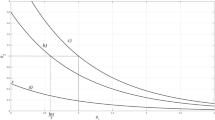Abstract
We consider the difference approximation of the one-dimensional Liouville equation for modeling the evolution of the sample distribution density (of the nonstationary time series) estimated by a histogram. It is shown that the change in the sample density of the distribution over a certain period of time can be numerically described as a solution of the Liouville equation if the initial density distribution is strictly positive in the internal class intervals. The algorithm for determining the corresponding rate is constructed and its mechanical and statistical meaning is shown as a semigroup equivalent in the Chernoff sense to the average semigroup, which generates the evolution of the distribution function.
Similar content being viewed by others
REFERENCES
V. S. Korolyuk, N. I. Portenko, A. V. Skorokhod, and A. F. Turbin, Handbook of Probability Theory and Mathematical Statistics (Nauka, Moscow, 1985) [in Russian].
N. Sh. Kremer and B. A. Putko, Econometrics (YuNITI- DANA, Moscow, 2002) [in Russian].
Yu. P. Lukashin, Adaptive Methods for Forecasting Economic Indicators (Statistika, Moscow, 1979) [in Russian].
Yu. N. Orlov and K. P. Osminin, “Sample distribution function construction for non-stationary time-series forecasting,” Mat. Model. 20 (9), 23–33 (2008).
A. D. Bosov, R. Sh. Kalmetev, and Yu. N. Orlov, “Sample distribution function construction for non-stationary time-series forecasting,” Mat. Model., No. 3, 97–107 (2014).
Yu. N. Orlov, Kinetic Methods for Studying Non-Stationary Time Series (MFTI, Moscow, 2014) [in Russian].
N. N. Kalitkin, Numerical Methods (Nauka, Moscow, 1978) [in Russian].
A. A. Samarskii and P. N. Vabishchevich, “Nonlinear monotonic schemes for the transport equation,” Dokl. Akad. Nauk 361, 21–23 (1998).
M. P. Galanin, “Numerical solution of the transport equation,” in The Future of Applied Mathematics. Lectures for Young Researchers, Collection of Articles, Ed. by G. G. Malinetskii (Editorial URSS, Moscow, 2005), pp. 78–116 [in Russian].
P. R. Chernoff, “Note on product formulas for operator semigroups,” J. Funct. Anal. 84, 238–242 (1968).
O. G. Smolyanov, H. Weizsacker, and O. Wittin, “Chernoff’s theorem and discrete time approximation of Brownian motion on manifolds,” Potential Anal. 26, 1–29 (2007).
Yu. N. Orlov, V. Zh. Sakbaev, and O. G. Smolyanov, “Feynman formulas as a method of averaging random Hamiltonians,” Tr. MIAN 285, 232–243 (2014).
Author information
Authors and Affiliations
Corresponding author
Ethics declarations
The authors declare that they have no conflicts of interest.
Additional information
Translated by L. Kartvelishvili
Rights and permissions
About this article
Cite this article
Kislitsin, A.A., Orlov, Y.N. Modeling the Evolution of the Sample Distributions of Random Variables Using the Liouville Equation. Math Models Comput Simul 12, 747–756 (2020). https://doi.org/10.1134/S2070048220050087
Received:
Revised:
Accepted:
Published:
Issue Date:
DOI: https://doi.org/10.1134/S2070048220050087



